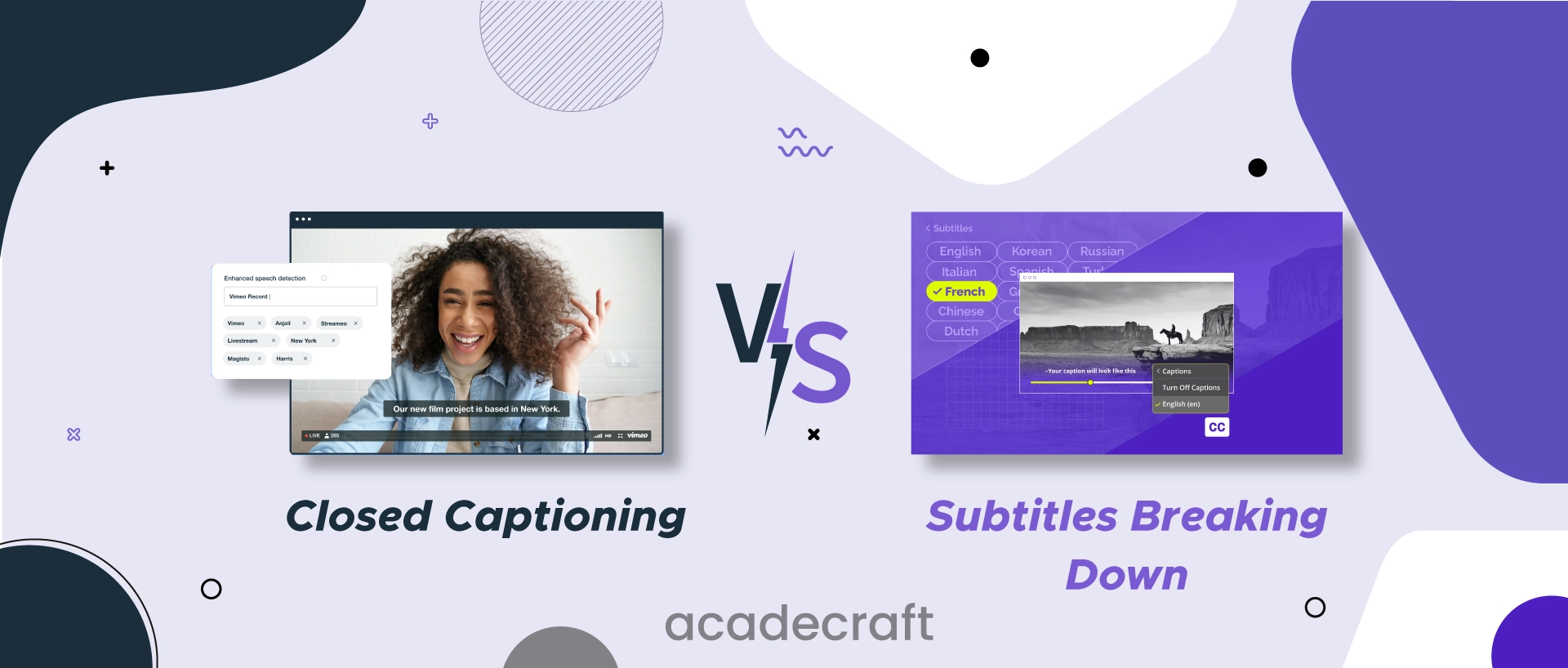
With the rapid advancement of digital technology, audiovisual content has become an integral part of our lives. "Closed captions" and "subtitles" are often used interchangeably, but they have different meanings. However, there is a subtle difference between the two that significantly impacts the way we consume and understand multimedia content.
Understanding the differences between closed captioning and subtitles is crucial in ensuring that all viewers can fully engage with multimedia content. In this guide, we will delve into the core disparities between the two. We'll examine their distinct purposes, how they are created, and the impact they have on content accessibility.
By the end of this journey, you'll have a clear understanding of when and why to choose one over the other, ensuring that your content resonates with diverse audiences while adhering to best practices in accessibility. By considering these distinctions and their impact on accessibility, content creators can make informed decisions that promote inclusivity and reach a wider audience.
Viewers, whether they are watching a movie, a YouTube video, or an educational documentary, often rely on textual aids to enhance their understanding of the content. Two such aids that play pivotal roles in this regard are subtitles and closed captions. Let us understand each one while exploring their key differences.
|
Aspect |
Closed Captioning |
Subtitles |
|
Primary Purpose |
Designed for viewers with hearing impairments. |
Aimed at a broader audience, including language learners and those in noisy environments. |
|
Content Detail |
Includes dialogue important audio cues (e.g., [background music], [sound effects]). |
Focuses solely on translating dialogue. |
|
Use of Sound Descriptions |
Often includes descriptions of sounds to enhance accessibility. |
Typically, it does not include sound descriptions. |
|
Language Options |
May offer translations, but the primary focus is on transcription and translation where necessary. |
Provides a wide array of language options for translation. |
|
Display Location |
Positioned at the bottom of the screen, near the speaker's dialogue. |
Generally displayed at the bottom footer of the screen, usually with a contrasting color or background for readability. |
|
Audience |
This is mainly intended for individuals with hearing impairments and is aimed at improving their comprehension. |
Targets a diverse audience, making content accessible to multilingual viewers and those in noisy environments. |
|
Inclusivity |
Enhances inclusivity by providing access to audio content for all viewers. |
Promotes inclusivity by breaking language barriers and aiding comprehension in various scenarios. |
|
Education and Learning |
It is valuable for learners, as it helps associate spoken words with their written counterparts. |
Supports language learning by providing a parallel translation of spoken content. |
|
Use in Noisy Environments |
It may be less effective in noisy surroundings due to reliance on audio cues. |
It is highly effective in noisy environments, as viewers can read subtitles even when audio clarity is compromised. |
|
Accessibility Compliance |
Often required for legal compliance and accessibility standards. |
Supports accessibility goals but may not be legally mandated in all cases. |
|
Accessibility for the Deaf |
A primary tool for making content accessible to users who are deaf or hard of hearing. |
Provides a secondary benefit for the deaf and hard of hearing but primarily addresses language barriers. |
|
Application Range |
It is commonly used in television, films, and online video platforms. |
Widely used in films, TV shows, online videos, and language-specific content. |
The table comparing captions vs subtitles serves as a valuable reference for individuals and businesses looking to utilize voice over services effectively. By understanding the distinctions outlined in the table, users can make informed and more precise decisions about when and how to complement voice-over with textual aids.
Bonus Read: A Comprehensive Guide to Voice Over
Closed captions and subtitles are the two most essential tools in the realm of audiovisual accessibility. They both involve displaying text on the screen while a video plays, but their purposes and functionalities differ significantly.
Closed captioning primarily serves the deaf and hard-of-hearing audience, providing not only the dialogue but also crucial audio cues like background sounds and music. Subtitles, on the other hand, offer translations and allow multilingual viewers to enjoy content in their preferred language.
Closed captioning, often abbreviated as CC, is a text-based overlay displayed on the screen that synchronizes with the audio content. It is primarily designed to provide access to auditory information for individuals with hearing impairments. However, its utility extends far beyond this audience.
Closed captioning is a versatile tool that fosters inclusivity in various scenarios:
Closed captioning is a meticulous process that involves several steps:
Unlike closed captions, subtitles are not intrinsically tied to audio cues or sounds. These are textual representations of the dialogue or narration in a video. They primarily serve the purpose of translating spoken content into written form, making videos accessible to a wider, often multilingual, audience.
Our subtitle services offer numerous benefits and applications:
The process of creating subtitles involves the following steps:
Accessibility is not just a choice but also an ethical requirement in the ever-expanding world of digital content. We have explored key differences and taken a closer look between Closed Captioning vs Subtitles.
Closed captioning is primarily created for those who are deaf or hard of hearing, providing a text description of the audio content, including dialogue, sound effects, and music. On the other hand, subtitles are primarily intended for audiences who may not understand the language being spoken in a video or film.
Subtitles provide a simpler translated version of the dialogue in another language. Both elements contribute to making digital content more accessible to a wider audience. They should be implemented to ensure inclusivity as an ethical requirement.
Share